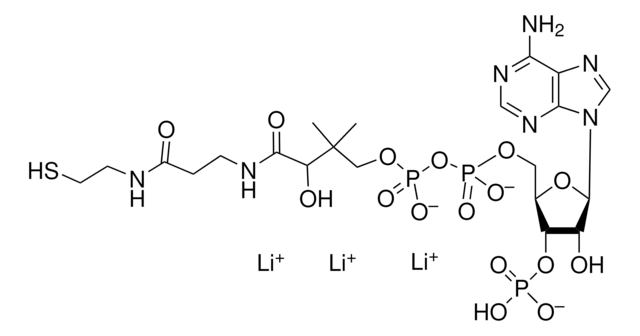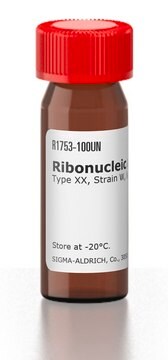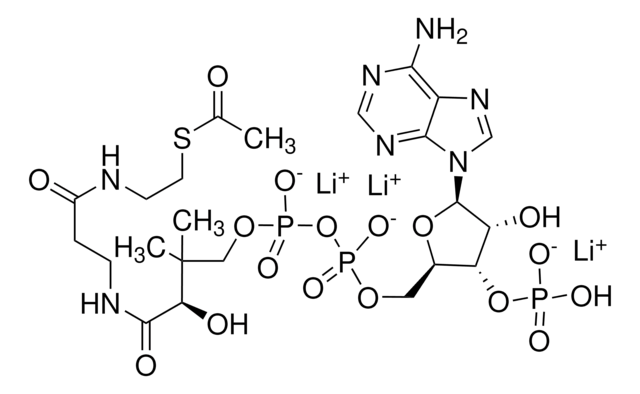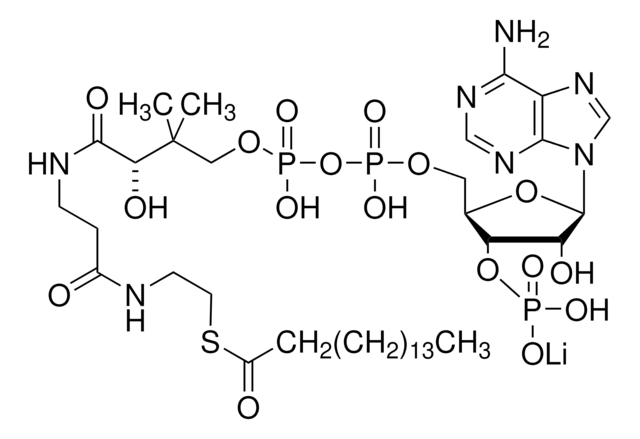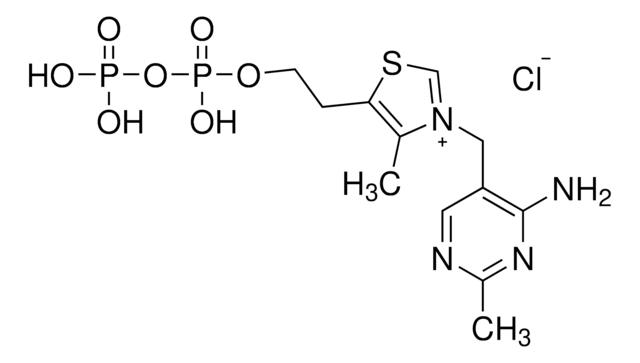모든 사진(3)
About This Item
실험식(Hill 표기법):
C21H36N7O16P3S · xH2O
CAS Number:
Molecular Weight:
767.53 (anhydrous basis)
Beilstein:
77809
MDL number:
UNSPSC 코드:
12352100
PubChem Substance ID:
NACRES:
NA.21
추천 제품
생물학적 소스
yeast
Quality Level
분석
≥85% (UV, HPLC)
양식
powder
작용기
phospholipid
배송 상태
ambient
저장 온도
−70°C
SMILES string
O.CC(C)(COP(O)(=O)OP(O)(=O)OC[C@H]1O[C@H]([C@H](O)[C@@H]1OP(O)(O)=O)n2cnc3c(N)ncnc23)[C@@H](O)C(=O)NCCC(=O)NCCS
InChI
1S/C21H36N7O16P3S.H2O/c1-21(2,16(31)19(32)24-4-3-12(29)23-5-6-48)8-41-47(38,39)44-46(36,37)40-7-11-15(43-45(33,34)35)14(30)20(42-11)28-10-27-13-17(22)25-9-26-18(13)28;/h9-11,14-16,20,30-31,48H,3-8H2,1-2H3,(H,23,29)(H,24,32)(H,36,37)(H,38,39)(H2,22,25,26)(H2,33,34,35);1H2/t11-,14-,15-,16+,20-;/m1./s1
InChI key
TVSAELAFGDOPKI-BLPRJPCASA-N
애플리케이션
Coenzyme A hydrate has been used in the thiolase enzyme assay of recombinant acetoacetyl-CoA thiolase (rACAT) in Clonorchis sinensis. It may be used as a reference standard in Raman spectra measurements.
생화학적/생리학적 작용
Coenzyme A (CoA) is an essential metabolic cofactor synthesized from cysteine, pantothenate, and ATP.
Coenzyme A (CoA) is an essential metabolic cofactor synthesized from cysteine, pantothenate, and ATP. CoA plays important roles in many metabolic pathways, including the tricarboxylic acid cycle, and the synthesis and oxidation of fatty acids. One of the main functions of CoA is the carrying and transfer of acyl groups. Acylated deriviates, for example acetyl-CoA, are critical intermediates in many metabolic reactions. CoA levels can be altered during starvation, and in conditions such as cancer, diabetes, and alcoholism.
주의사항
The free acid is less stable than the sodium or lithium salt; 5% decomposition may occur within 6 months when stored at −80 °C.
Storage Class Code
11 - Combustible Solids
WGK
WGK 3
Flash Point (°F)
Not applicable
Flash Point (°C)
Not applicable
이미 열람한 고객
Takuya Ishibashi et al.
Extremophiles : life under extreme conditions, 16(6), 819-828 (2012-09-04)
We have previously reported that the majority of the archaea utilize a novel pathway for coenzyme A biosynthesis (CoA). Bacteria/eukaryotes commonly use pantothenate synthetase and pantothenate kinase to convert pantoate to 4'-phosphopantothenate. However, in the hyperthermophilic archaeon Thermococcus kodakarensis, two
Francis McCoy et al.
Molecular cell, 52(3), 325-339 (2013-10-08)
Active metabolism regulates oocyte cell death via calcium/calmodulin-dependent protein kinase II (CaMKII)-mediated phosphorylation of caspase-2, but the link between metabolic activity and CaMKII is poorly understood. Here we identify coenzyme A (CoA) as the key metabolic signal that inhibits Xenopus
Johannes Holert et al.
Journal of bacteriology, 195(3), 585-595 (2012-12-04)
Bacterial degradation of steroids is widespread, but the metabolic pathways have rarely been explored. Previous studies with Pseudomonas sp. strain Chol1 and the C(24) steroid cholate have shown that cholate degradation proceeds via oxidation of the A ring, followed by
Clonorchis sinensis acetoacetyl-CoA thiolase: identification and characterization of its potential role in surviving in the bile duct
Lin J, et al.
Parasites & vectors, 8(1), 125-125 (2015)
John C Newman et al.
The Journal of biological chemistry, 287(51), 42436-42443 (2012-10-23)
The sirtuins are a family of NAD(+)-dependent protein deacetylases that regulate cell survival, metabolism, and longevity. Three sirtuins, SIRT3-5, localize to mitochondria. Expression of SIRT3 is selectively activated during fasting and calorie restriction. SIRT3 regulates the acetylation level and enzymatic
자사의 과학자팀은 생명 과학, 재료 과학, 화학 합성, 크로마토그래피, 분석 및 기타 많은 영역을 포함한 모든 과학 분야에 경험이 있습니다..
고객지원팀으로 연락바랍니다.
